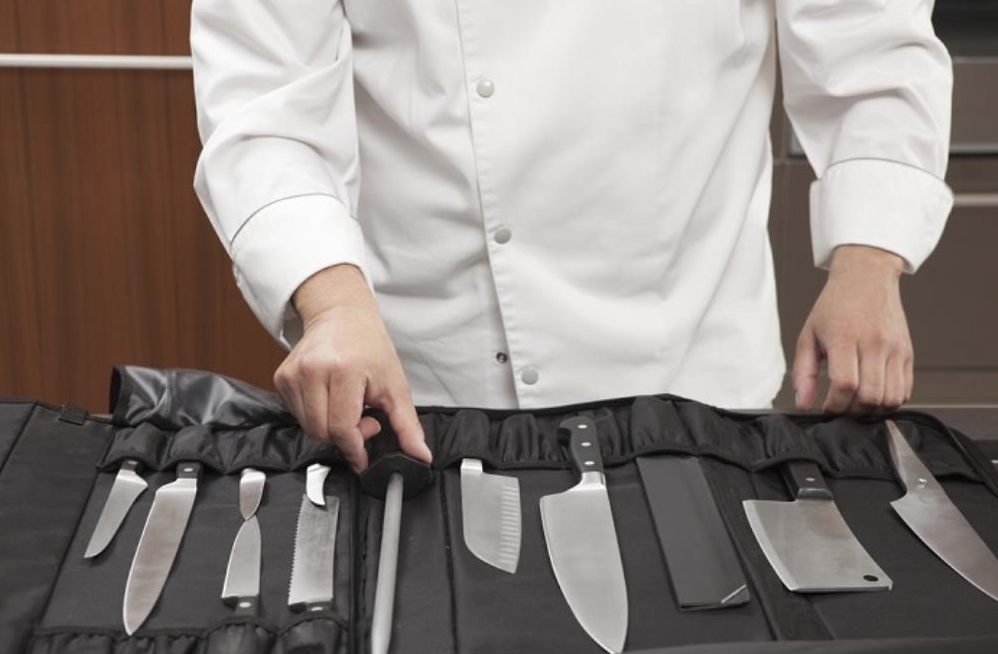You have decided to update your cooking skills and plan to do it by purchasing new equipment. The time when you are searching for the right knife is the T-1 of your development. If you have heard of chef’s knives – the multipurpose tools that professional chefs and restaurant personnel use, you should start looking for the right product at once. But how can you do it without knowing the main differences between chef’s knives first?
Chef’s knives differ as some are heavier for extra balance, while others have smaller blades for increased precision. All chef’s knives are built to be safe, balanced, and have extremely sharp blades for a smooth cutting process. Here are the main differences between various chef’s knives.

Image Source: Depositphotos.com
Key Features of All Chef’s Knives
- Blade: Blades are usually 6-to-10-inch-wide depending on customers’ preferences. The specialized website Chef Knives Expert has compiled a list of the best premium quality chef knives that you can check out. You will notice that eight out of the ten reviewed knives have 8-inch blades for extra versatility.
- Handle: The handle should offer a firm grip. A knife’s handle sets up its balance and affects its overall weight. Although they come in different shapes and materials, deciding upon a specific handle style is a matter of personal choice and the ability to operate the knife efficiently.
- Bolster: The wedge-shaped area between the blade and the handle directly contributes to your ability to control cutting. This feature is missing from Japanese-style and stamped products.
Blade Material
Blades are typically made of:
- High-carbon steel: The higher-carbon content in the blade keeps the edge sharp for longer but makes the knife more expensive. Such blades are resistant and rust-resistant.
- Stainless steel: The most common and most affordable option is the stainless-steel blade. It might need re-sharpening once every few months; such an edge offers high performance while cutting.
- Damascus steel: A Damascus steel blade contains two types of steel alloy forged together into multiple layers. The core is typically made of carbon steel, covered in stainless steel. The edge is therefore sharp while the blade’s main features remain protected.
- Ceramic: These knives are easy to maintain and lightweight. Some might chip under pressure, but they work best for carving, slicing, dicing, and filleting.
Knife Style
The Western-style chef knife originates in Germany and France. Such knife is typically made of carbon steel and ceramic or high carbon and stainless steel. Blades are 8-to-10-inch wide and have a cutting angle of 20-to-22 degrees. The angle ensures the knife a smooth cutting process and easy transfer of food.
You recognize this style by the pointy tip and curved cutting edge. Those are heavy-duty knives due to their large handles and bolsters – which also add a bit of extra weight.
The Santoku chef knife is the champion of slicing, dicing and mincing, although you can use it for nearly all tasks. This Japanese design is made of stainless and/or carbon steel and also ceramic. The blade is light and thin and usually includes more layers. The 12 to 15-degrees angle of the blade makes it easier to use for small-sized cutting. Also, the end is curved to support smooth slicing of rich textures, such as meat or a soft cake. The edges typically have dimples which prevent the food from sticking to the knife’s blade.
Blades are shorter to ensure very precise cutting, so you might not be able to carve with such a knife. Some models have an asymmetric grind which means that it can only be used with one hand.
Manufacturing Process
- Stamped knife: The blade is cut or stamped from a large sheet of steel, honed and heat-treated. It is typically lighter than a forged knife. Stamped knives are cheaper as the manufacturing process involves less effort than forging.
- Forged knife: Made of a single steel bar, the forged knife goes through heating, pounding into shape, and cooling. Forged knives feature a bolster to balance weight. They also have full or partial tang (which we will discuss below). Moreover, the handle has metal rivets for an easy grip.
Additional Key Features
The tang is that non-sharp part of the blade connected to the handle. A knife can be either full or half tang. Full tang knives have blades with extra strength and balance, while half tang knives are good for prep work and cutting small pieces. A good knife should naturally drag your hand back and forth during cutting, without needing pressure from you.
These are the main differences between chef’s knives. Finding the best chef’s knives in uk is a matter of personal preferences. You can discover what you really need from a knife and how to choose one by testing out several products. Also, read reviews, expert opinions, and user feedback and find your favorite!
















Add Your Comment